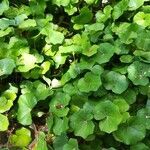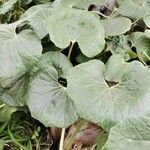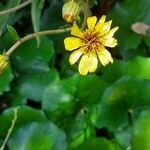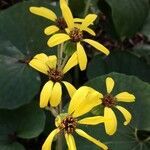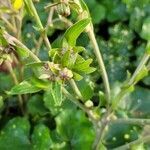Rhizomes stout, 1-2 cm in diam. Scape to 70 cm tall, 5-6 mm in diam. at base, initially densely shortly pale yellow pilose, glabrescent. Leaves with petiole 15-25 cm, initially densely shortly pale yellow pilose, ± glabrescent, amplexicaul, sheath densely villous inside; leaf blade abaxially pale green, adaxially green, reniform, 9-13 × 11-22 cm, subleathery, initially gray puberulent, glabrescent, base cordate, margin entire or dentate to palmatilobed, apex rounded; sinus ca. 1/3 as long as leaf blade. Stem leaves bracteal, oblong or linear-lanceolate, 1-2 cm. Capitula 2-7 in corymb; peduncles 2-13 cm, puberulent. Involucre campanulate or broadly turbinate, 1.2-1.5 cm, mouth to 1.5 cm in diam., outside puberulent; phyllaries 12-14, oblong, apex acuminate; inner phyllaries broadly membranous at margin. Ray florets 8-12, yellow; lamina oblong or spatulate-oblong, 1.5-2.2 cm × 3-4 mm, apex rounded or acute. Tubular florets numerous, 1-1.2 cm; tube ca. 6 mm. Achenes ca. 7 mm, ribbed, hairy. Pappus white, as long as tubular corolla. Fl. and fr. Aug to following Mar. 2n = 60.
More
An evergreen herb. It keeps growing from year to year. The leaf stem is 30-40 cm long. The flower stalk is 30-75 cm high. The leaves are at the base near ground level and are kidney shaped. They are leathery and 15-20 cm long by 25 cm wide. They are thick and have a long leaf stalk. The flowers are yellow. The flower heads are 4-6 cm across.
The young leaves are eaten. The leaf stalks are boiled in water to remove the harsh flavour, then peeled and used to add flavour to salads and other dishes. Caution: It contains chemicals that cause cancer and therefore needs treatment.

